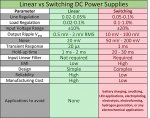Verti
0
- Joined
- Jul 1, 2018
- Messages
- 2
- Points
- 0
Will this Power Supply be a good choice to run and test Laser Diodes?
Tekpower TP3005N Regulated DC Variable Power Supply, 0 - 30V at 0 - 5A
Adjustable outputs: 0-30V and 0-5A Variable controls for both current and voltage outputs
Input voltage: 110V
Regulation: CV <= 0.02% + 10 mV
Load Regulation: CV <= 0.02% + 5mV,
Ripple noise: CV <= 100 mVp-p
Protection: Current Limit
Environment: 0-40C, relative humidity < 80%


https://www.amazon.com/gp/product/B078MY5RGQ/ref=ox_sc_act_title_12?smid=AMH4W1K8OCGMX&psc=1
Tekpower TP3005N Regulated DC Variable Power Supply, 0 - 30V at 0 - 5A
Adjustable outputs: 0-30V and 0-5A Variable controls for both current and voltage outputs
Input voltage: 110V
Regulation: CV <= 0.02% + 10 mV
Load Regulation: CV <= 0.02% + 5mV,
Ripple noise: CV <= 100 mVp-p
Protection: Current Limit
Environment: 0-40C, relative humidity < 80%


https://www.amazon.com/gp/product/B078MY5RGQ/ref=ox_sc_act_title_12?smid=AMH4W1K8OCGMX&psc=1





